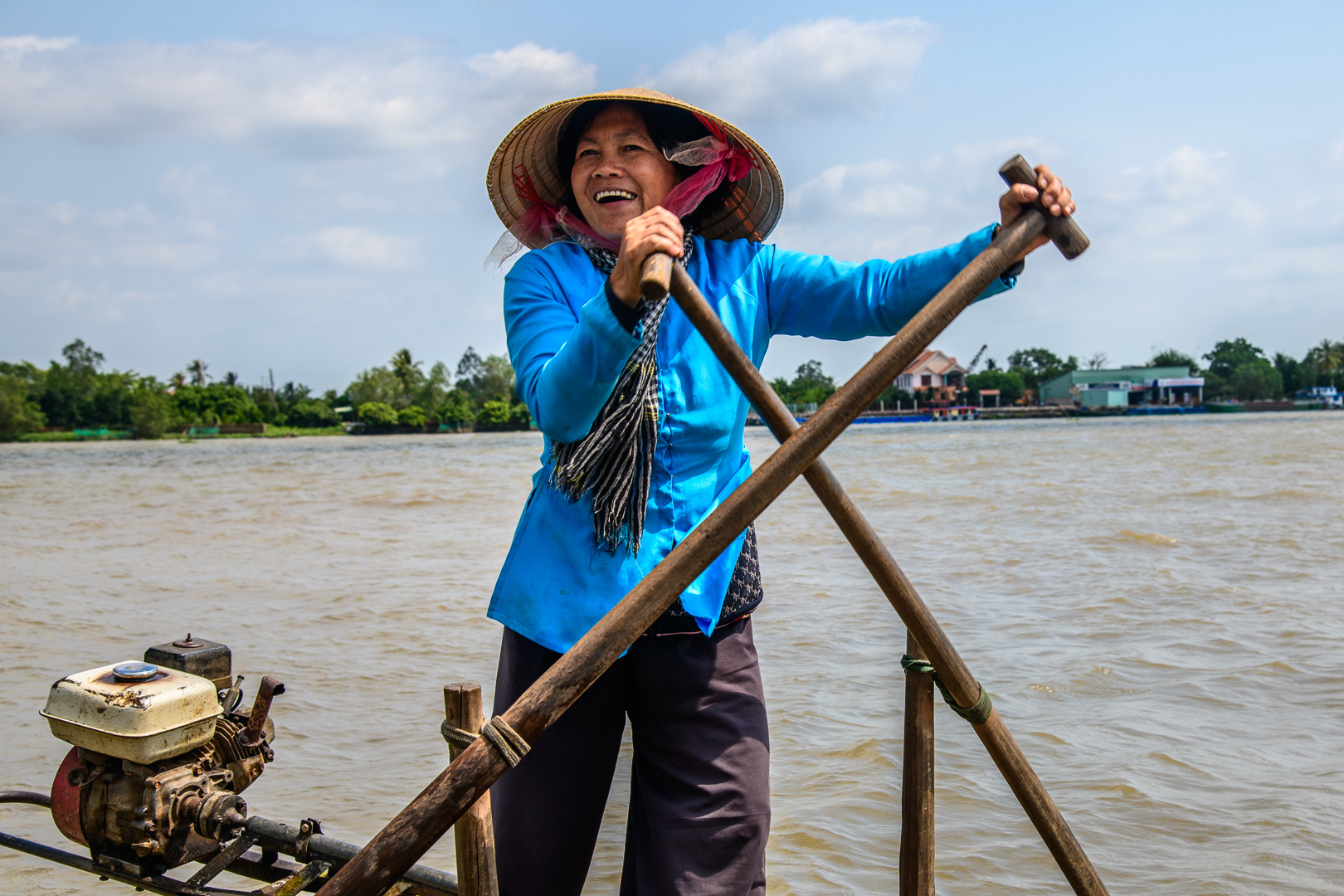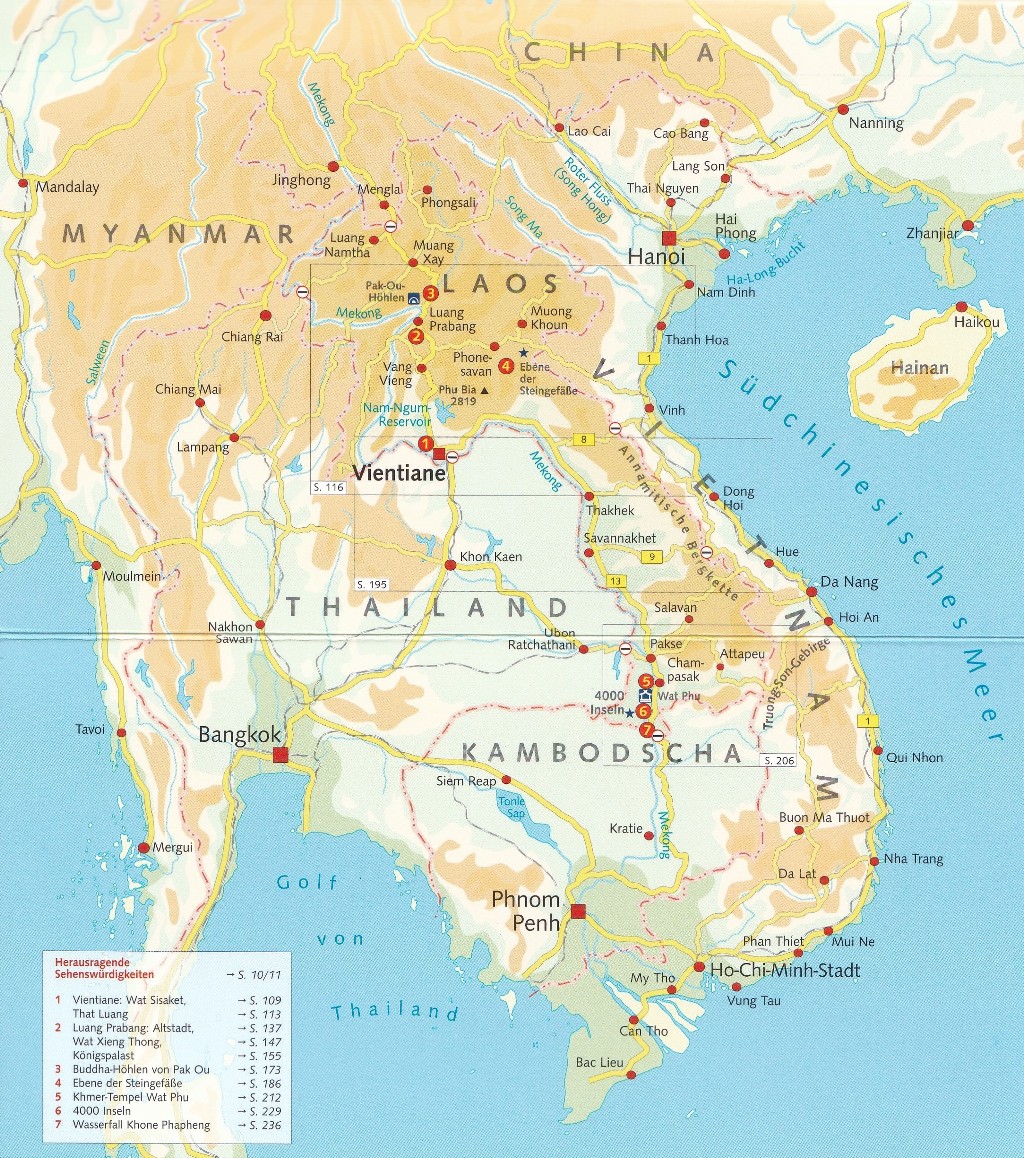
Indochina
Indochina, also called (until 1950) French Indochina is comprised of the three states of Laos, Vietnam and Cambodia formerly associated with France, first within its empire and later within the French Union. The term Indochina refers to the intermingling of Indian and Chinese influences in the culture of the region.
Programme
Contents
Laos
Laos, a landlocked country of northeast-central mainland Southeast Asia, consists of an irregularly round portion in the north that narrows into a peninsula-like region stretching to the southeast. Overall, the country extends for 1,050 km from northwest to southeast. The capital is Vientiane, located on the Mekong River in the northern portion of the country. Laos is bounded to the north by China, to the northeast and east by Vietnam, to the south by Cambodia, to the west by Thailand, and to the northwest by Myanmar (Burma). Dominating the landscape of Laos are its inhospitable forest-covered mountains, which in the north rise to a maximum elevation of 2,818 metres above sea level at Mount Bia and in many places constitute an impediment to travel.
The geologically diverse landscape of Laos, with its forested mountains, upland plateaus and lowland plains, supports an equally diverse population that is united largely through agriculture, particularly the cultivation of rice. Interactions—sometimes hostile, sometimes hospitable—with the neighbouring Khmer (Cambodian), Siamese (Thai), and Myanmar (Burmese) kingdoms between the 5th and the mid-19th century indirectly imbued Laos with elements of Indian culture, including Buddhism, the religion now practiced by most of the population. Both Buddhist and Hindu beliefs have shaped the visual, performing, and literary arts of the country. The predominant religion today is Theravada Buddhism. However, many of the indigenous and minority peoples of the remote highland slopes and mountainous regions have maintained their own idiosyncratic ritual and artistic traditions.
Colonization by the French from the late 19th to the mid-20th century infused Laos with a European cultural element, which intensified throughout the country’s embroilment in World War II and the Indochina wars, as well as a civil war of its own in the second half of the 20th century. Guided by Marxist-Leninist ideology, Laos emerged from the turmoil in 1975 as a communist country. Economic reforms of the late 20th and early 21st centuries, including the development of tourism, have strengthened Laos’s economy, gradually shrinking the country’s debt and diminishing its dependence on international aid.
Vietnam
Vietnam occupies the eastern portion of mainland Southeast Asia. With an area and configuration similar to those of Norway, Vietnam extends for 1,650 km from north to south and is only about 50 km wide east to west at its narrowest part. It is bordered by China to the north, the South China Sea to the east and south, the Gulf of Thailand (Gulf of Siam) to the southwest, and Cambodia and Laos to the west. Vietnam’s principal geographic features are the Annamese Cordillera extending generally from northwest to southeast in central Vietnam and dominating the interior, and two extensive alluvial deltas formed by the Red (Hong) River in the north and the Mekong (Long) River in the south. Between these two deltas lies a long, relatively narrow coastal plain.
The capital, Hanoi, is located in the north, while the country’s largest city, Ho Chi Minh City (formerly Saigon), is in the south. Vietnam experienced a period of prolonged warfare in the mid-20th century, and a partitioning (1954–75), first militarily and later politically, into the Democratic Republic of Vietnam, better known as North Vietnam, and the Republic of Vietnam, usually called South Vietnam. Fighting between South Vietnam and the North Vietnamese-backed Việt Cộng escalated into what became known as the Vietnam War – although the Vietnamese officially refer to it as the American War. Following reunification in April 1975, the Socialist Republic of Vietnam was established in July 1976. The Vietnam war was only one of many that the Vietnamese have fought, but it was the most brutal in its history.
Tribal Viets inhabiting the Red River delta entered written history when China’s southward expansion reached them in the 3rd century BC. From that time onward, a dominant theme of Vietnam’s history has been interaction with China, the source of most of Vietnam’s high culture. Occupied by China no fewer than four times, the Vietnamese managed to fight off the invaders just as often. Confucianism, Daoism, and Mahayana Buddhism entered Vietnam over many centuries. Gradually they became intertwined, simplified, and Vietnamized to constitute, along with vestiges of earlier local beliefs, an indigenous religion that came to be shared to some considerable extent by all Vietnamese, regardless of region or social class. It is largely this religious amalgam that is practiced by the roughly half of the population that identifies itself as being Buddhist. The religion of Cao Dai, a synthesis of Confucianism, Daoism, Buddhism, and Roman Catholicism, appeared during the 1920s, and in the 1930s the Hoa Hao neo-Buddhist sect spread through parts of the Mekong delta. Local religions involving numerous spirits predominate in many upland communities, and most Cham are adherents of Islam.
Thus Vietnam has a long history of affiliating with a dominant civilization and adapting that civilization’s ideas, institutions, and technology to Vietnamese purposes. This pattern reappeared as descendants of mandarins responded to the challenge of the West by rejecting tradition and becoming communists to combat colonialism and it was evident again as it animated 20th-century artistic movements that employed Western forms to promote social renovation. Since the 1980s it has been the driving force behind the Vietnam Communist Party’s embrace of economic liberalization and integration into the world economy. Such strategic absorption and adaptation have helped propel Vietnam to become one of the world’s most populous countries, with one of the most rapidly expanding market economies. Over two thirds of the current population were born after 1975. American tourists will receive a particularly friendly welcome in Vietnam, as many young Vietnamese imitate American customs and venerate US pop culture.
Cambodia
Cambodia is largely a land of plains and great rivers and lies amid important overland and river trade routes linking China to India and Southeast Asia. The influences of many Asian cultures, alongside those of France and the United States, can be seen in the capital, Phnom Penh, one of a handful of urban centres in the largely rural country. Cambodia, about one-third the size of France, is bordered to the west and northwest by Thailand, to the northeast by Laos, to the east and southeast by Vietnam, and to the southwest by the Gulf of Thailand. The country’s maximum extent is about 450 km from north to south and 580 km from east to west. Cambodia’s landscape is characterized by a low-lying central alluvial plain that is surrounded by uplands and low mountains and includes the Tonle Sap (Great Lake) and the upper reaches of the Mekong River delta.
For 2,000 years Cambodia’s civilization absorbed influences from India and China and, in turn, transferred them to other Southeast Asian civilizations. From the Hindu-Buddhist kingdoms of Funan and Chenla (1st–8th century) through the classical age of the Angkor period (9th–15th century), it held sway over territories that are now part of Thailand, Vietnam, and Laos. The Khmer (Cambodian) empire reached its apex in the 12th century, a time marked by the construction of the massive temple complexes known as Angkor Wat and Bayon and the imperial capital of Angkor Thom. Most ethnic Khmer are Theravada (Hinayana) Buddhists (i.e., belonging to the older and more traditional of the two great schools of Buddhism, the other school being Mahayana). Until 1975 Buddhism was officially recognized as the state religion of Cambodia.
Following 400 years of decline, Cambodia became a French colony and during the 20th century experienced the turmoil of war, occupation by the Japanese, post war independence, and political instability. Between 1975 and 1979 the country was devastated by the reign of the Khmer Rouge, a rural communist guerrilla movement. During the Khmer Rouge’s period of power, at least 1.5 million Cambodians were killed or died, a monumental tragedy from which the country still suffers. Cambodia began the process of recovery under the Vietnam-backed regime of the People’s Republic of Kampuchea (1979–89), and in the 1990s it regained political autonomy, re-established a constitutional government, and subsequently instituted free elections. The Cambodian economy has steadily improved, and the country seems to be living by the words of the Cambodian proverb, “Fear not the future, weep not for the past.”

